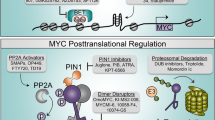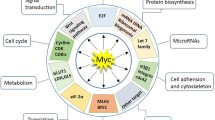Summary
Background The MYC oncogene is one of the most frequently altered driver genes in cancer. MYC is thus a potential _target for cancer treatment as well as a biomarker for the disease. However, as a _target for treatment, MYC has traditionally been regarded as “undruggable” or difficult to _target. We set out to evaluate the efficacy of a novel MYC inhibitor known as MYCMI-6, which acts by preventing MYC from interacting with its cognate partner MAX. Methods MYCMI-6 response was assessed in a panel of breast cancer cell lines using MTT assays and flow cytometry. MYC gene amplification, mRNA and protein expression was analysed using the TCGA and METABRIC databases. Results MYCMI-6 inhibited cell growth in breast cancer cell lines with IC50 values varying form 0.3 μM to >10 μM. Consistent with its ability to decrease cell growth, MYCMI-6 was found to induce apoptosis in two cell lines in which growth was inhibited but not in two cell lines that were resistant to growth inhibition. Across all breast cancers, MYC was found to be amplified in 15.3% of cases in the TCGA database and 26% in the METABRIC database. Following classification of the breast cancers by their molecular subtypes, MYC was most frequently amplified and exhibited highest expression at both mRNA and protein level in the basal subtype. Conclusions Based on these findings, we conclude that for patients with breast cancer, anti-MYC therapy is likely to be most efficacious in patients with the basal subtype.




Similar content being viewed by others
Data availability
Bioinformatic data was retrieved from the TCGA and METABRIC datasets, which can be accessed via the TCGA-Data portal (https://portal.gdc.cancer.gov/) and cBioportal (https://www.cbioportal.org/study/summary?id=brca_metabric) respectively.
References
Dang CV (2016) A time for MYC: metabolism and therapy. Cold Spring Harb Symp Quant Biol 81:79–83
Wolpaw AJ, Dang CV (2018) MYC-induced metabolic stress and tumorigenesis. Biochim Biophys Acta Rev Cancer 1870(1):43–50
Carroll PA, Freie BW, Mathsyaraja H, Eisenman RN (2018) The MYC transcription factor network: balancing metabolism, proliferation and oncogenesis. Front Med 12(4):412–425
Beroukhim R, Mermel CH, Porter D, Wei G, Raychaudhuri S, Donovan J, Barretina J, Boehm JS, Dobson J, Urashima M, Mc Henry KT, Pinchback RM, Ligon AH, Cho YJ, Haery L, Greulich H, Reich M, Winckler W, Lawrence MS, Weir BA, Tanaka KE, Chiang DY, Bass AJ, Loo A, Hoffman C, Prensner J, Liefeld T, Gao Q, Yecies D, Signoretti S, Maher E, Kaye FJ, Sasaki H, Tepper JE, Fletcher JA, Tabernero J, Baselga J, Tsao MS, Demichelis F, Rubin MA, Janne PA, Daly MJ, Nucera C, Levine RL, Ebert BL, Gabriel S, Rustgi AK, Antonescu CR, Ladanyi M, Letai A, Garraway LA, Loda M, Beer DG, True LD, Okamoto A, Pomeroy SL, Singer S, Golub TR, Lander ES, Getz G, Sellers WR, Meyerson M (2010) The landscape of somatic copy-number alteration across human cancers. Nature 463(7283):899–905
Schaub FX et al (2018) Pan-cancer alterations of the MYC oncogene and its proximal network across the cancer genome Atlas. Cell Syst 6(3):282–300.e2
Priestley P, Baber J, Lolkema MP, Steeghs N, de Bruijn E, Shale C, Duyvesteyn K, Haidari S, van Hoeck A, Onstenk W, Roepman P, Voda M, Bloemendal HJ, Tjan-Heijnen VCG, van Herpen CML, Labots M, Witteveen PO, Smit EF, Sleijfer S, Voest EE, Cuppen E (2019) Pan-cancer whole-genome analyses of metastatic solid tumours. Nature 575(7781):210–216
Kalkat M, et al. (2017) MYC deregulation in primary human cancers. Genes (Basel), 8(6)
Ping Z, Xia Y, Shen T, Parekh V, Siegal GP, Eltoum IE, He J, Chen D, Deng M, Xi R, Shen D (2016) A microscopic landscape of the invasive breast cancer genome. Sci Rep 6:27545
Zhang G, Wang Y, Chen B, Guo L, Cao L, Ren C, Wen L, Li K, Jia M, Li C, Mok H, Chen X, Wei G, Lin J, Zhang Z, Hou T, Han-Zhang H, Liu C, Liu H, Liu J, Balch CM, Meric-Bernstam F, Liao N (2019) Characterization of frequently mutated cancer genes in Chinese breast tumors: a comparison of Chinese and TCGA cohorts. Annals of translational medicine 7(8):179
Casey SC, Baylot V, Felsher DW (2018) The MYC oncogene is a global regulator of the immune response. Blood 131(18):2007–2015
Dang CV, Reddy EP, Shokat KM, Soucek L (2017) Drugging the 'undruggable' cancer _targets. Nat Rev Cancer 17(8):502–508
Fletcher S, Prochownik EV (2015) Small-molecule inhibitors of the Myc oncoprotein. Biochim Biophys Acta 1849(5):525–543
McKeown MR, Bradner JE (2014) Therapeutic strategies to inhibit MYC. Cold Spring Harb Perspect Med, 4(10)
Chen H, Liu H, Qing G (2018) _targeting oncogenic Myc as a strategy for cancer treatment. Signal Transduction and _targeted Therapy 3(1):5
Castell A, Yan Q, Fawkner K, Hydbring P, Zhang F, Verschut V, Franco M, Zakaria SM, Bazzar W, Goodwin J, Zinzalla G, Larsson LG (2018) A selective high affinity MYC-binding compound inhibits MYC:MAX interaction and MYC-dependent tumor cell proliferation. Sci Rep 8(1):10064
Synnott NC, Murray A, McGowan PM, Kiely M, Kiely PA, O'Donovan N, O'Connor DP, Gallagher WM, Crown J, Duffy MJ (2017) Mutant p53: a novel _target for the treatment of patients with triple-negative breast cancer? Int J Cancer 140(1):234–246
Chou TC (2010) Drug combination studies and their synergy quantification using the Chou-Talalay method. Cancer Res 70(2):440–446
The Cancer Genome Atlas (TCGA). Available from: https://portal.gdc.cancer.gov/
Curtis C et al (2012) The genomic and transcriptomic architecture of 2,000 breast tumours reveals novel subgroups. Nature 486(7403):346–352
Getz G, Beroukhim R, Mermel C, Schumacher S, Dobson J (2016) Genomic identification of significant _targets in cancer. Available from: ftp://ftp.broadinstitute.org/pub/genepattern/modules_public_server_doc/GISTIC2.pdf
Benjamini Y, Hochberg Y (1995) Controlling the false discovery rate: a practical and powerful approach to multiple testing. Journal of the Royal Statistical Society. Series B (Methodological) 57(1):289–300
RStudio-Team. RStudio: Integrated Development for R. . (2015); Available from: http://www.rstudio.com/ or http://cran.r-project.org/
Whitfield JR, Beaulieu M-E, Soucek L (2017) Strategies to inhibit Myc and their clinical applicability. Frontiers in cell and developmental biology 5:10
Beaulieu ME, Jauset T, Masso-Valles D (2019) Intrinsic cell-penetrating activity propels Omomyc from proof of concept to viable anti-MYC therapy. 11(484)
Trapani D, Rajasekar AKA, Mathew A (2019) More options for adjuvant treatment of HER2-positive breast cancer: how to choose wisely? Int J Cancer 145(11):2901–2906
Chen S, et al. (2019) Efficacy and safety of HER2 inhibitors in combination with or without pertuzumab for HER2-positive breast cancer: a systematic review and meta-analysis. 19(1): 973
Pegram MD, Konecny G, Slamon DJ (2000) The molecular and cellular biology of HER2/neu gene amplification/overexpression and the clinical development of herceptin (trastuzumab) therapy for breast cancer. Cancer Treat Res 103:57–75
Green AR, Aleskandarany MA, Agarwal D, Elsheikh S, Nolan CC, Diez-Rodriguez M, Macmillan RD, Ball GR, Caldas C, Madhusudan S, Ellis IO, Rakha EA (2016) MYC functions are specific in biological subtypes of breast cancer and confers resistance to endocrine therapy in luminal tumours. Br J Cancer 114(8):917–928
Garrido-Castro AC, Lin NU, Polyak K (2019) Insights into molecular classifications of triple-negative breast cancer: improving patient selection for treatment. Cancer discovery 9(2):176–198
Howlader N, Cronin KA, Kurian AW, Andridge R (2018) Differences in breast Cancer survival by molecular subtypes in the United States. Cancer epidemiology, biomarkers & prevention : a publication of the American Association for Cancer Research, cosponsored by the American Society of Preventive Oncology 27(6):619–626
Wang E, et al. (2019) Tumor penetrating peptides inhibiting MYC as a potent _targeted therapeutic strategy for triple-negative breast cancers. 38(1): 140–150
Schafer JM, Lehmann BD (2020) _targeting MYCN-expressing triple-negative breast cancer with BET and MEK inhibitors. 12(534)
Funding
We thank the Cancer Clinical Research Trust and the Irish Research Council (EPSPG/2019/507) for funding this work.
Author information
Authors and Affiliations
Contributions
DAS performed the bioinformatics analysis of TCGA and METABRIC databases. EK performed the cell growth and apoptosis experiments. SOG analysed the results of the cell line studies and constructed Figs. 1-3. AJE co-supervised the bioinformatics analysis. AC and LGL discovered and validated the MYCMI-6 inhibitor. JC contributed to the writing of the manuscript with particular input to potential clinical applications of our findings. SFM supervised the bioinformatic analysis and wrote this section of the manuscript. MJD conceived the project and supervised the cell line studies. All authors contributed to the writing of the manuscript.
Corresponding author
Ethics declarations
Conflict of interest
DA, SO’G, EK, AJE, AC, LGL, SM & MJD have no conflicts of interest. JC has received honoraria from Eisai, Amgen, Puma Biothechnology, Seattle Genetics, Boehringer Ingelheim, Pfizer, Vertex and Genomic Health. He has acted in an advisory/consulting role to Eisai, Puma Biotechnology, Boehringer Ingelheim, Pfizer, Vertex, Roche. He also serves on the Speakers’ Bureau for Pfizer, Eisai and Genomic Health and has received Research Funding from Roche, Eisai, Boehringer Ingelheim and Puma Biotechnology. In addition, he has received travel, accommodation and expenses from MSD, Pfizer, Roche, AstraZeneca, Abbvie and Novartis. Finally, he is an employee of OncoMark, has stocks in OncoMark and is named on patent WO2020011770 (A1) - A method of predicting response to treatment in cancer patients.
Ethical approval
This study utilised commercially available cell lines and bioinformatics analysis of previously published, publicly available databases. No human or animal subjects were used in this study.
Informed consent
For this type of study, formal consent is not required.
Additional information
Publisher’s note
Springer Nature remains neutral with regard to jurisdictional claims in published maps and institutional affiliations.
Electronic supplementary material
ESM 1
Kaplan-Meier overall survival (OS) curve for the total population of breast cancer patients with high MYC amplification from METABRIC (A) and TCGA (B). P-values, HR and 95% confidence interval (CI) are shown. Kaplan-Meier OS curve plotting the survival probability of breast cancer patients with the basal PAM50 subtype in METABRIC (C) and TCGA (D). P-values, HR and 95% CI are shown. (PDF 383 kb)
ESM 2
Kaplan-Meier OS curves for MYC mRNA levels, dichotomized based on median expression levels for total population of breast cancer patients for METABRIC (A) and TCGA (B). P-values, HR and 95% CI are shown. Kaplan-Meier OS curves for MYC mRNA levels, dichotomized based on median expression levels for breast cancer patients with basal PAM50 subtype in METABRIC (C) and TCGA (D). P-values, HR and 95% CI are shown. (PDF 386 kb)
ESM 3
Kaplan-Meier overall survival curve for MYC protein levels for total population of breast cancer patients (A) and in the PAM50 basal subtype of breast cancer (B). P-values, HR and 95% CI are shown. (PDF 227 kb)
Rights and permissions
About this article
Cite this article
AlSultan, D., Kavanagh, E., O’Grady, S. et al. The novel low molecular weight MYC antagonist MYCMI-6 inhibits proliferation and induces apoptosis in breast cancer cells. Invest New Drugs 39, 587–594 (2021). https://doi.org/10.1007/s10637-020-01018-w
Received:
Accepted:
Published:
Issue Date:
DOI: https://doi.org/10.1007/s10637-020-01018-w




